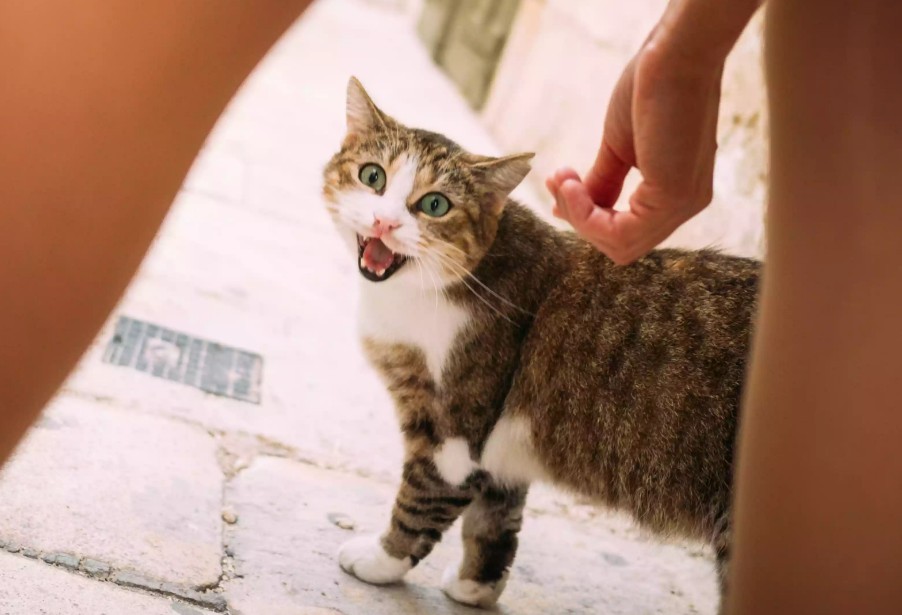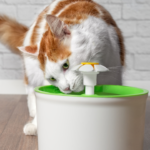
How Cats Can Help Children With Autism Become More Social
April 1, 2023
What happened to “Youngest Old Cat Lady”?
April 14, 2023Behavior changes in cats

Knowing which cat behaviors are normal is the key to recognizing any behavioral problems or changes in your pet feline. Once you know what behaviors you should expect to see in your cat, you’ll be better able to identify any changes that may be a cause for alarm.
Aggressive Behavior Changes
Some cats have a stronger prey-drive and will act out aggressively towards toys, children, other pets, or even you.
This aggressive behavior is a natural and often normal thing a prey-driven cat will have if it does not have another outlet to hunt and catch. But if a cat that has normally not been aggressive suddenly starts acting out, then this is a cause for concern.
A cat that is not normally prey-driven and is hissing, swatting, biting, and overall aggressive towards other pets and/or people is probably trying to tell you something.
Pain and fear are often the reasons for a cat to have a behavior change that results in aggression.
Events that can cause a cat to be fearful include negative veterinary or boarding facility visits, new animals in the household or visible outside, negative encounters with people, new smells on you or your cat’s belongings, and more.
RELATED: Aggression between housemates
Pain may be elicited from recent surgery, a trauma-inducing accident such as a tail getting stuck in a door, old surgeries such as declawing or other amputation, dental disease, or illness.
Resolving the aggressive behavior may mean finding and eliminating the cause of the pain or fear, using medications and behavior supplements, and reassuring your cat. Discipline is not the solution for aggressive behavior in cats.
Changes in Eating Behavior
Cats are creatures of habit. They will quickly learn when it’s mealtime if you meal feed or that there is always food available if you elect to leave a bowl out.
If your cat’s speed of eating or the amount of food consumed changes drastically, then it may be an indication of a problem.
If your cat is eating more food than they used to and not gaining weight, you may want to ask your veterinarian about hyperthyroidism.2 This is a common thyroid problem in older cats and it will cause your cat to never feel full but also prevent them from gaining weight.
People with untreated hyperthyroid cats often describe their cat’s appetites as ravenous and that they will try to eat anything that isn’t nailed down.
RELATED: How to tell your cat is sick
If your cat starts to eat less or stops eating altogether, it is a good indication that it is not feeling well, has dental disease, or is stressed. Of course, some cats are simply just picky eaters and prefer certain flavors of food but if your cat is not eating and is also vomiting, lethargic, and/or losing weight, you should have your veterinarian check them out.
Hairballs may work themselves out of the body but sometimes they, and other items, get stuck in the gastrointestinal tract, tumors can cause digestive issues, and other illnesses may cause a cat to stop eating.
Playing Behavior Changes
Some cats are naturally more playful than others and, just like people, they have individual personalities. But when a regularly playful cat doesn’t want to play like it used to, it may be cause for concern.
A cat that doesn’t feel well or is in pain may not want to jump around and chase toys. A veterinary visit may be in order if your cat does not return to a normal playful cat after a couple of days.
Hiding Behavior Changes
Cats that do not feel well or are scared are likely to hide and some people even feel a cat that goes off on their own may sense that the end of its life is near. Fear is usually the driving force behind why a cat hides though, and it often follows a stressful or traumatic event.
RELATED : Interacting with a shy cat
Veterinary visits, people visiting in your cat’s home that they aren’t used to, a change in your schedule, and new pets may all cause your cat to hide. If the hiding is due to an event then your cat should return to normal after a few days but if it is due to an illness or pain they may need to be checked out by the veterinarian.
Nutritional supplements and pheromones may help with stress and fear but medications may be needed to treat an illness or pain.
Elimination Behavior Changes
Possibly the number one reason for cats to be relinquished, euthanized, and abandoned is an elimination problem.3 Behavior changes in the urination and defecation habits of your cat are most often related to stress, fear, or a lack of appropriate, clean, litter box options.
Some cats suddenly choose to defecate and/or urinate outside of their box and this behavior is your cat trying to tell you something.
They may not like the size of the box, the kind of litter, how dirty the litter is, the placement of the box, or the number of litter box options they have.
RELATED: Is your cat peeing outside the litterbox?
They may also be trying to tell you that they don’t feel well and that they have a urinary tract infection or pain from a digestive tract problem.4 Medical reasons for elimination behavior changes should always be ruled out prior to fixing any environmental issues.
Many other things can cause elimination behavior changes and even the experts do not fully understand all the reasons behind them. But if you notice abnormally large clumps of litter from urine, spots of blood in the litter box, no or very little clumps of litter from urine, or your cat is straining, crying, or eliminating outside of the litter box, you should not hesitate to bring them into the veterinarian.
Male cats can become unable to urinate and this creates a life-threatening issue in a short amount of time.
Scratching Behavior Changes
Scratching is a normal cat behavior, but if your cat suddenly starts scratching more, especially in one particular spot, it could be an indication that they are stressed.
Nutritional supplements designed to relax your cat without sedating it, as well as pheromones, may help lower your cat’s stress level. Otherwise, think about any changes in the environment that may have negatively impacted your cat and do your best to correct them.
Scratching is a form of marking and it leaves a cat’s scent on the item. The drive to scratch and mark is natural but if a cat is stressed it will be exacerbated.
Sleeping Behavior Changes
Cats who are not feeling well may sleep more than usual. There is, of course, the simple possibility that your cat is just lazy and/or overweight, but if a cat starts sleeping more than they used to you should schedule a visit to your veterinarian.
Grooming Behavior Changes
Grooming is a natural thing cats do. They typically groom themselves and others when they are relaxed or feel as though their fur was somehow messed up.
Cats that stop grooming or have a major decrease in self-grooming are oftentimes ill and should be checked out by a veterinarian.
Sometimes cats who are gaining weight are unable to reach certain areas on their body, therefore they are unable to groom themselves. This can be fixed by encouraging your cat to lose the extra weight.
Sore joints and muscles are also a contributing factor in grooming. Cats that have osteoarthritis or injuries may not be able to reach certain areas to groom that they used to be able to reach.
Vocalization Behavior Changes
Cats have many vocalizations and reasons for making them. Crying and yowling are indications of distress, confusion, fear, or pain and if your cat is making these noises, there is typically something wrong.
RELATED: What is your cat trying to tell you?
If your cat starts vocalizing more at night, it may be due to cognitive dysfunction.5 If they start vocalizing by hissing or growling, it is most likely due to pain or fear.
Assess the situation and think about what changes could be causing the vocalizations. If you cannot think of any reasons for the sudden noises your cat is making, consider scheduling a visit with your veterinarian to see if there is a medical reason causing distress in your cat.
Some cats will vocalize before vomiting a hairball, at mealtime, during other regular activities, or not at all, but the change in vocalizations, not necessarily the regularity, is what should be monitored.






